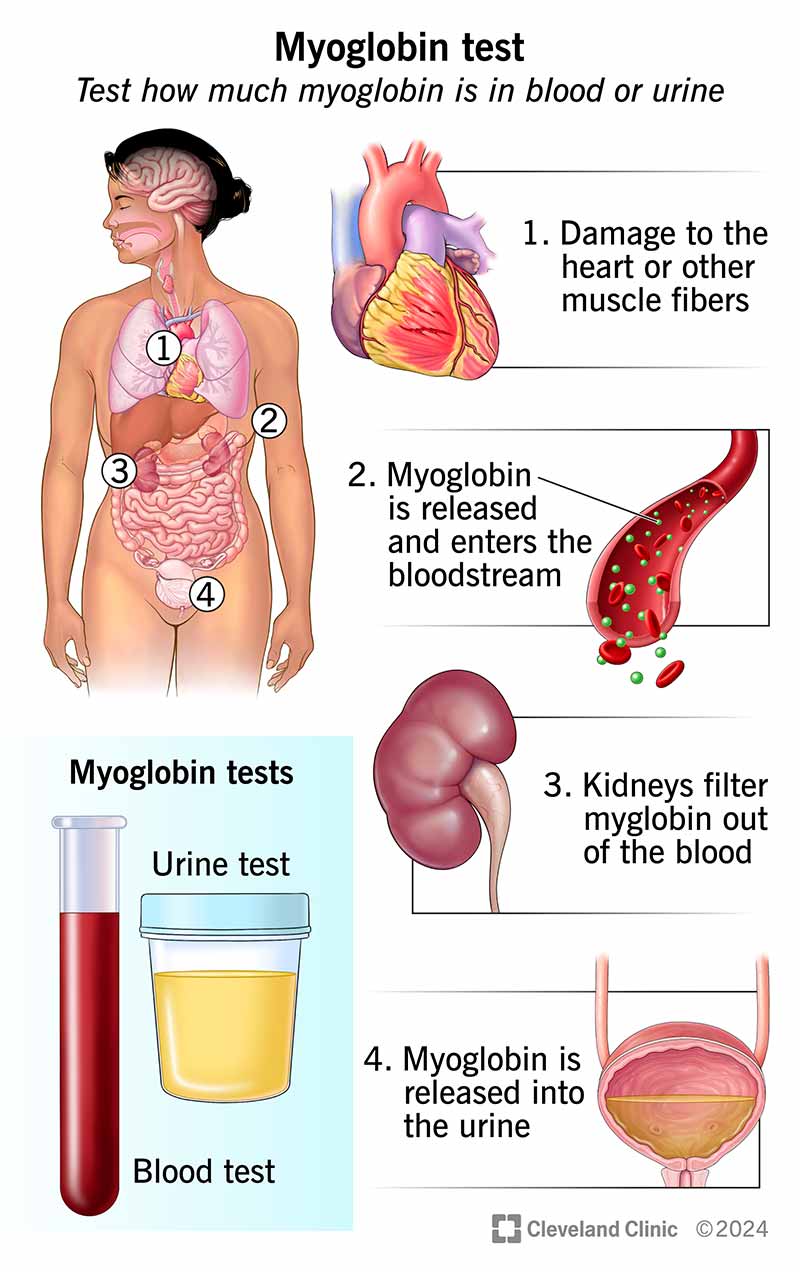Myoglobin is a protein in your muscles that helps them get the oxygen they need to keep moving. But it can be a sign of muscle damage if it’s in your blood or pee. Healthcare providers test for it with a simple blood or urine test. You may need other tests to confirm the exact cause.
Advertisement
Cleveland Clinic is a non-profit academic medical center. Advertising on our site helps support our mission. We do not endorse non-Cleveland Clinic products or services. Policy

A myoglobin test measures how much myoglobin is in your blood or pee (urine).
Advertisement
Cleveland Clinic is a non-profit academic medical center. Advertising on our site helps support our mission. We do not endorse non-Cleveland Clinic products or services. Policy
Myoglobin is typically found in your muscle fibers. But if something damages your heart or other muscles, the torn fibers can release myoglobin into your bloodstream. Your kidneys filter that myoglobin out of your blood and release it into your pee.
Healthcare providers use myoglobin tests to check for signs of muscle damage. They might suggest a test to help diagnose a few issues, including:
Myoglobin is a protein in your skeletal muscles and your heart. It transports oxygen from your bloodstream to your muscles. Your muscles need oxygen to work properly. Myoglobin is like a tiny delivery vehicle. It’s made of amino acids, iron and other molecules that work together to hold onto oxygen. It delivers that oxygen to your muscles when they need it to convert stored energy into movements.
There are two types of myoglobin tests:
Advertisement
There’s no special prep you need to do for either type of myoglobin test. You can eat, drink and take your medications like you normally would.
Your provider will take the sample of your blood or pee and send it to a lab. The lab will tell your provider how much myoglobin is in it.
Both kinds of myoglobin tests are safe and have no risk of severe side effects.
You might feel a sting or pinch when your provider puts the needle into your vein for a blood test. You might have a small bruise afterward. But those are usually the only side effects.
Your test results will show how much myoglobin is in your blood or if there is any in your pee.
Healthcare providers classify myoglobin blood levels as normal or high. Normal myoglobin level for a blood test is usually less than 72 ng/mL (nanograms per milliliter). Some labs use different ranges to measure myoglobin levels. The results of your test might use a slightly different normal or high range. Your provider will help you understand the results of your test. They’ll tell you if need follow-up tests, appointments or treatments.
There usually shouldn’t be any detectable myoglobin in your pee. So, your provider may do a blood test to check your myoglobin level if they detect any myoglobin in a urine test.
A normal myoglobin level means you have an expected or typical amount of myoglobin in your blood. A high myoglobin level can be a sign of heart or other muscle damage.
A myoglobin test can’t diagnose what caused the damage. It just shows that it probably happened recently. Myoglobin in your blood or pee is a clue your provider can use to diagnose an injury or health condition.
Think about it like this. If you notice muddy footprints by the door, you can probably guess that someone forgot to take their shoes off when they got home. You can’t tell for sure which of your family members tracked the mud in just from the footprints. But you know they were there.
Myoglobin in your blood or pee is like those muddy footprints — it’s a step in the right direction to figure out if something is damaging your muscles.
Talk to a healthcare provider if you experience any of the following symptoms:
A myoglobin test is a quick, easy way for your healthcare provider to check for signs of muscle damage. Once they have the results of the simple blood or urine test, they’ll be able to narrow in on a diagnosis. You might need other tests or some new treatments. But you’ll be one step closer to understanding what’s going on inside your body and causing the symptoms you’re experiencing.
Advertisement
Cleveland Clinic’s primary care providers offer lifelong medical care. From sinus infections and high blood pressure to preventive screening, we’re here for you.

Last reviewed on 03/20/2025.
Learn more about the Health Library and our editorial process.